
thecodersgig
TheCodersGig is a AI Powered open source platform for devs where they can connect and discuss technology . It will be having integrated utility marketplace where devs can create utility plugins in a ease
Stars: 66
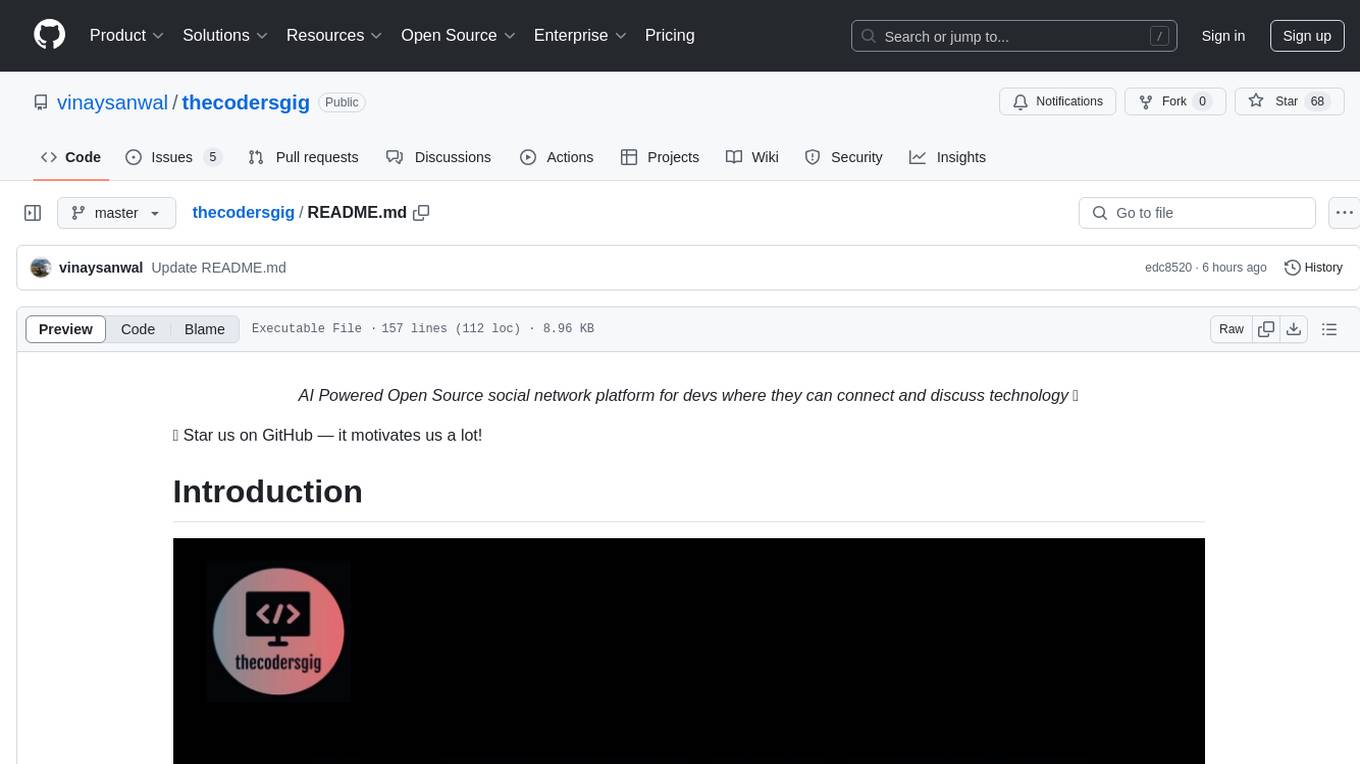
TheCodersGig is an AI-powered open-source social network platform for developers, facilitating seamless connection and collaboration. It features an integrated utility marketplace for creating plugins easily, automating backend development with scalable code. The user-friendly interface supports API integration, data models, databases, authentication, and authorization. The platform's architecture includes frontend, backend, AI services, database, marketplace, security, and DevOps layers, enabling customization and diverse integrations. Key components encompass technologies like React.js, Node.js, Python-based AI frameworks, SQL/NoSQL databases, payment gateways, security protocols, and DevOps tools for automation and scalability.
README:
AI Powered Open Source social network platform for devs where they can connect and discuss technology 🚀
⭐ Star us on GitHub — it motivates us a lot!
TheCodersGig is a robust, open-source development platform designed to revolutionize the social network platform.
It will be having integrated utility marketplace where devs can create utility plugins in a ease.
We automate your backend applications development, ensuring consistency, predictability, and adherence to the highest standards with code that’s built to scale
Our user-friendly interface fosters seamless integration of APIs, data models, databases, authentication, and authorization. Built on a flexible, plugin-based architecture, codersgig allows effortless customization in creating new plugins , utility or template etc and offers a diverse range of integrations.
The system will be composed of several layers:
- Frontend (User Interface)
- Backend (Application Logic and APIs)
- AI Services Layer
- Database Layer
- Marketplace Layer
- Security Layer
- DevOps and CI/CD Pipelines
- Technologies: React.js, Angular, or Vue.js for web; React Native or Flutter for mobile.
-
Description: The frontend will consist of a social network-style user interface for developers to connect, share knowledge, and collaborate on projects, as well as a marketplace for buying/selling developer tools, code snippets, and services.
- Social Network Features: Profiles, posts, likes, comments, direct messaging, and groups for collaboration.
- Marketplace Features: Listings for tools and services, search filters, ratings, reviews, and transaction support.
- Technologies: Node.js with Express or Django/Flask for Python; GraphQL for API querying; gRPC or RESTful APIs.
-
Description: The backend is the core of the application that will manage user sessions, social networking features, transaction handling, and AI integration.
- Microservices Architecture: Each function such as user authentication, social feed, marketplace, and AI services will run as individual microservices to allow for scalability.
- Social Features: APIs for user profiles, feed generation, comments, and notifications.
- Marketplace Management: APIs for handling product listings, transactions, digital goods delivery, and escrow services for payments.
- Technologies: Python-based AI frameworks (TensorFlow, PyTorch), natural language processing (NLP), recommendation systems, machine learning models.
-
Description: AI will power features such as content recommendation, search optimization, and even code review and generation tools.
- Recommendation Engine: Uses collaborative filtering, NLP, and machine learning to suggest relevant content (e.g., blog posts, projects, marketplace items) based on user interactions and preferences.
- AI Code Review Tools: Integrated system that analyzes code snippets shared by users and provides AI-driven feedback or optimizations.
- AI-Powered Marketplace Search: Optimizes the search and discovery of developer tools, frameworks, and services through semantic analysis.
- Auto-tagging and Categorization: Automatic tagging and categorization of user posts, projects, or marketplace items based on AI analysis of the content.
-
Technologies:
- SQL (PostgreSQL): For storing structured data like user profiles, marketplace listings, and transactions.
- NoSQL (MongoDB, Cassandra): For unstructured data such as posts, comments, and messages.
- ElasticSearch: For high-performance full-text search and indexing, especially useful for the marketplace and content recommendations.
- Description: The database layer is responsible for securely storing and retrieving all necessary data while ensuring high availability and scalability.
-
Technologies:
- Payment Gateway: Stripe, PayPal, or blockchain-based transactions.
- Smart Contracts (Optional): For secure, automated transactions in a decentralized marketplace.
-
Description: The marketplace will enable developers to buy and sell digital products (code snippets, APIs, libraries) or services (code review, freelancing).
- Payment Processing: Secure payment gateways for transactions.
- Escrow System: For holding funds during a transaction until both parties agree on completion.
- Digital Asset Management: Secure storage and transfer of digital goods.
- Technologies: OAuth 2.0 for authentication, JWT (JSON Web Tokens) for session management, SSL/TLS for secure communication.
-
Description: Security will be paramount for protecting user data, marketplace transactions, and intellectual property.
- Authentication & Authorization: User authentication using OAuth 2.0 with multi-factor authentication (MFA) for added security.
- Data Encryption: Encrypt all sensitive data at rest and in transit.
- DDOS Protection & Firewalls: Use cloud services like AWS WAF or Cloudflare for traffic filtering and protection against malicious attacks.
- Technologies: Docker for containerization, Kubernetes for orchestration, Jenkins/GitLab CI for continuous integration and deployment, Terraform for infrastructure as code.
-
Description: Implement robust DevOps pipelines for automating deployment, testing, and scaling of the services.
- Continuous Integration: Automated testing and code validation before deploying to production.
- Scalability: Use container orchestration to scale individual microservices dynamically based on demand.
- Monitoring: Integrate logging (ELK stack) and monitoring systems (Prometheus, Grafana) to ensure system health and reliability.
- Users sign up or log in using OAuth (e.g., GitHub, Google).
- JWT is issued to the client for subsequent API calls.
- MFA can be enabled for security.
- Users create profiles, post updates, and follow other developers.
- The recommendation engine suggests content based on user interactions.
- AI monitors posts, code snippets, and project discussions to offer suggestions or optimizations.
- Users browse or search for products/services using the AI-powered search.
- Transactions are initiated via a secure payment gateway.
- Funds are held in escrow until the product is delivered and both parties are satisfied.
- Users can review and rate marketplace transactions, improving the recommendation algorithm.
- Horizontal Scaling: Microservices architecture allows each component to scale independently based on load.
- Load Balancer: Use load balancers (AWS Elastic Load Balancing or NGINX) to distribute traffic evenly across services.
- Caching: Implement caching for frequently accessed data (e.g., popular posts, user profiles) using Redis or Memcached.
- CDN: Use a Content Delivery Network (CDN) to distribute static assets like images and JavaScript files globally, improving latency.
- Personalized Feed: Machine learning models track user behavior and preferences to curate a highly personalized social feed.
- Intelligent Code Suggestions: The platform analyzes shared code and provides real-time suggestions for improvement or detects errors.
- Marketplace Recommendations: AI recommends relevant tools, services, or code snippets based on a user’s activity and preferences.
- Frontend: React.js / Angular / Vue.js, React Native / Flutter.
- Backend: Node.js / Django, GraphQL, gRPC, REST APIs.
- AI/ML: TensorFlow, PyTorch, Scikit-learn, NLP libraries (spaCy).
- Databases: PostgreSQL, MongoDB, ElasticSearch.
- DevOps: Docker, Kubernetes, Jenkins, Terraform.
- Security: OAuth 2.0, JWT, SSL/TLS encryption.
This architecture will provide a scalable, secure, and highly interactive platform where developers can connect, share knowledge, and engage in a marketplace tailored to their professional needs.
To build the packages, follow these steps:
# Open a terminal (Command Prompt or PowerShell for Windows, Terminal for macOS or Linux)
# Ensure Git is installed
# Visit https://git-scm.com to download and install console Git if not already installed
npm run dev
## 📝 Youtube => https://www.youtube.com/@sanparadox1
# Clone the repository
git clone https://github.com/vinaysanwal/thecodersgig.git
For Tasks:
Click tags to check more tools for each tasksFor Jobs:
Alternative AI tools for thecodersgig
Similar Open Source Tools

thecodersgig
TheCodersGig is an AI-powered open-source social network platform for developers, facilitating seamless connection and collaboration. It features an integrated utility marketplace for creating plugins easily, automating backend development with scalable code. The user-friendly interface supports API integration, data models, databases, authentication, and authorization. The platform's architecture includes frontend, backend, AI services, database, marketplace, security, and DevOps layers, enabling customization and diverse integrations. Key components encompass technologies like React.js, Node.js, Python-based AI frameworks, SQL/NoSQL databases, payment gateways, security protocols, and DevOps tools for automation and scalability.
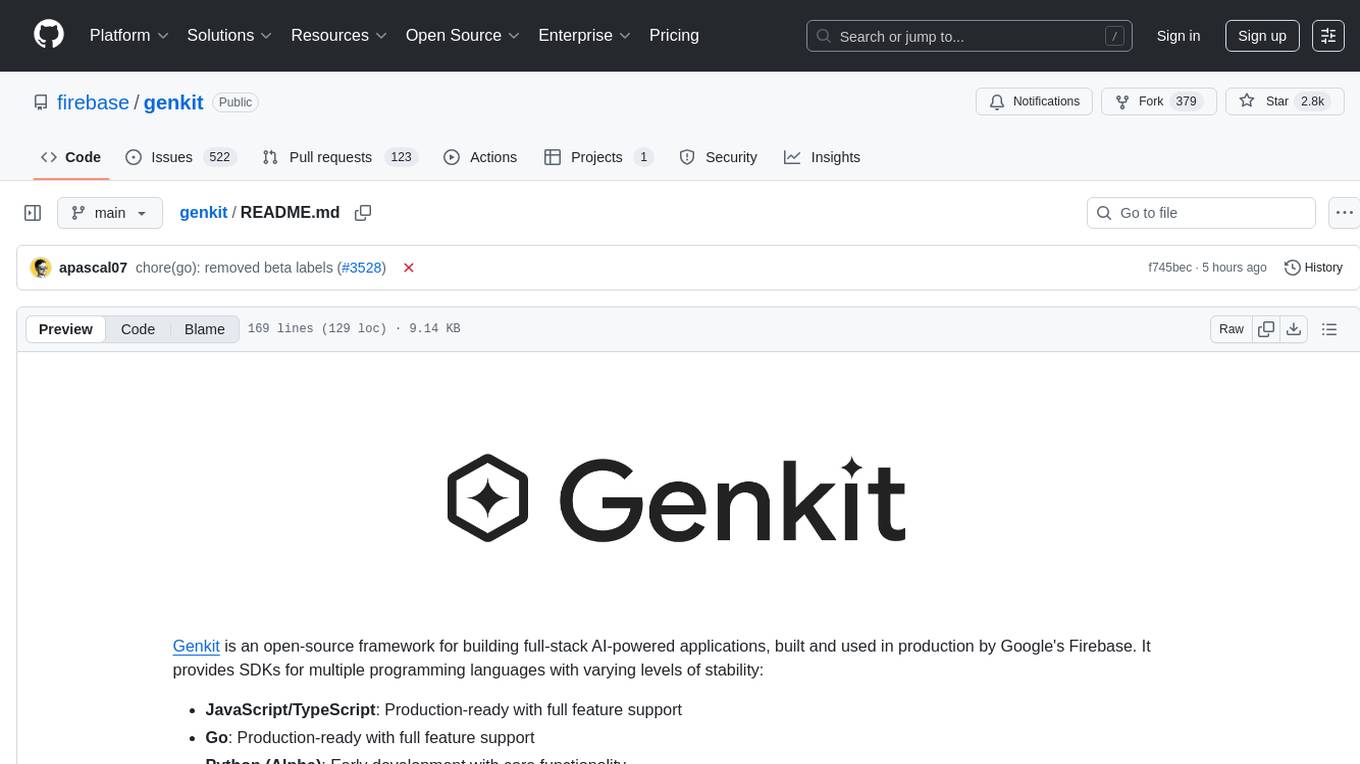
Genkit
Genkit is an open-source framework for building full-stack AI-powered applications, used in production by Google's Firebase. It provides SDKs for JavaScript/TypeScript (Stable), Go (Beta), and Python (Alpha) with unified interface for integrating AI models from providers like Google, OpenAI, Anthropic, Ollama. Rapidly build chatbots, automations, and recommendation systems using streamlined APIs for multimodal content, structured outputs, tool calling, and agentic workflows. Genkit simplifies AI integration with open-source SDK, unified APIs, and offers text and image generation, structured data generation, tool calling, prompt templating, persisted chat interfaces, AI workflows, and AI-powered data retrieval (RAG).
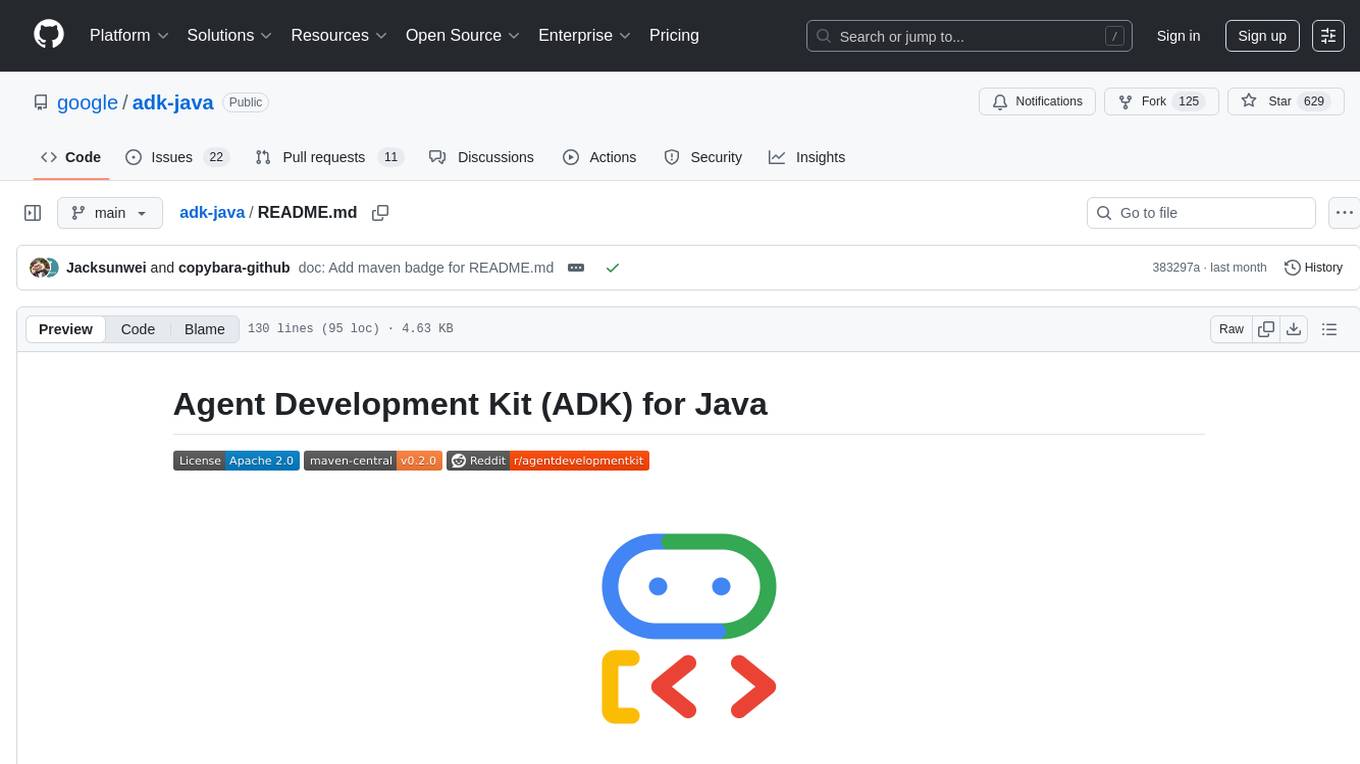
adk-java
Agent Development Kit (ADK) for Java is an open-source toolkit designed for developers to build, evaluate, and deploy sophisticated AI agents with flexibility and control. It allows defining agent behavior, orchestration, and tool use directly in code, enabling robust debugging, versioning, and deployment anywhere. The toolkit offers a rich tool ecosystem, code-first development approach, and support for modular multi-agent systems, making it ideal for creating advanced AI agents integrated with Google Cloud services.
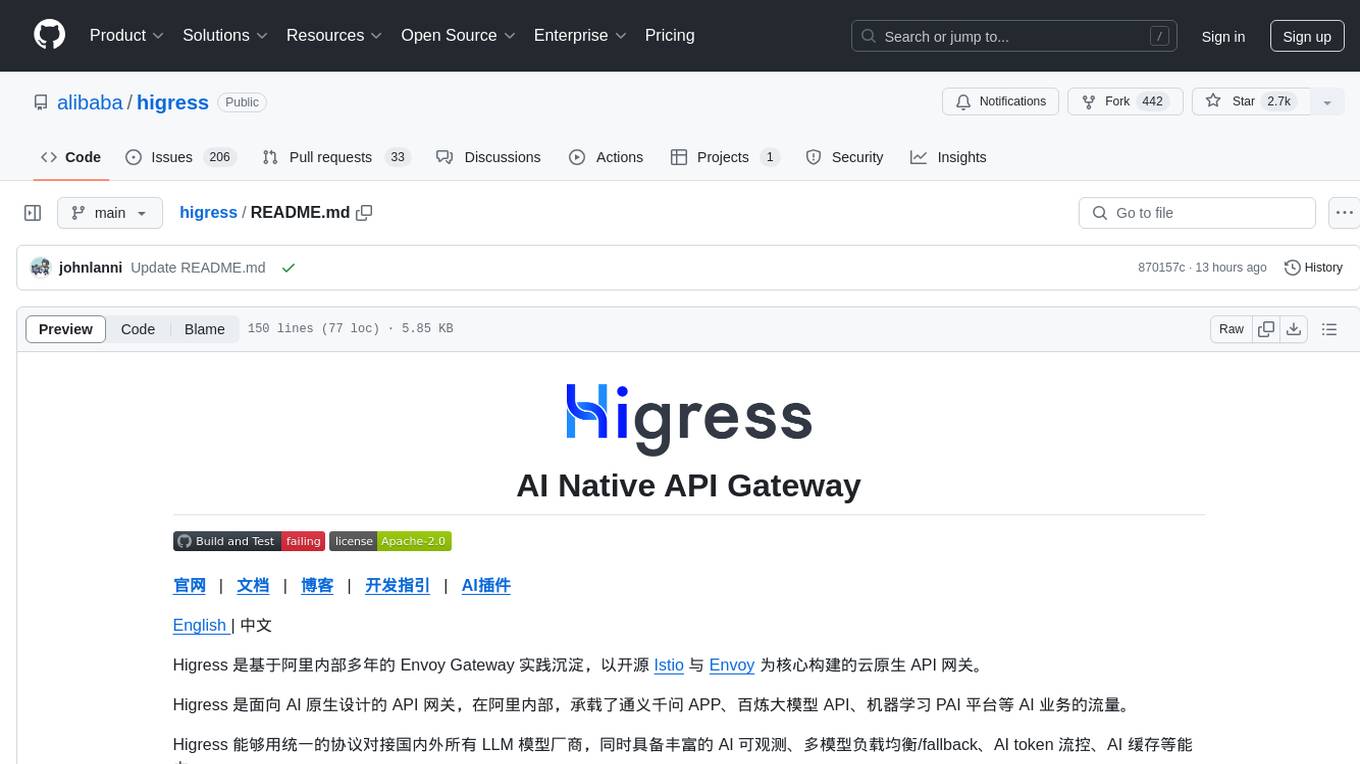
higress
Higress is an open-source cloud-native API gateway built on the core of Istio and Envoy, based on Alibaba's internal practice of Envoy Gateway. It is designed for AI-native API gateway, serving AI businesses such as Tongyi Qianwen APP, Bailian Big Model API, and Machine Learning PAI platform. Higress provides capabilities to interface with LLM model vendors, AI observability, multi-model load balancing/fallback, AI token flow control, and AI caching. It offers features for AI gateway, Kubernetes Ingress gateway, microservices gateway, and security protection gateway, with advantages in production-level scalability, stream processing, extensibility, and ease of use.
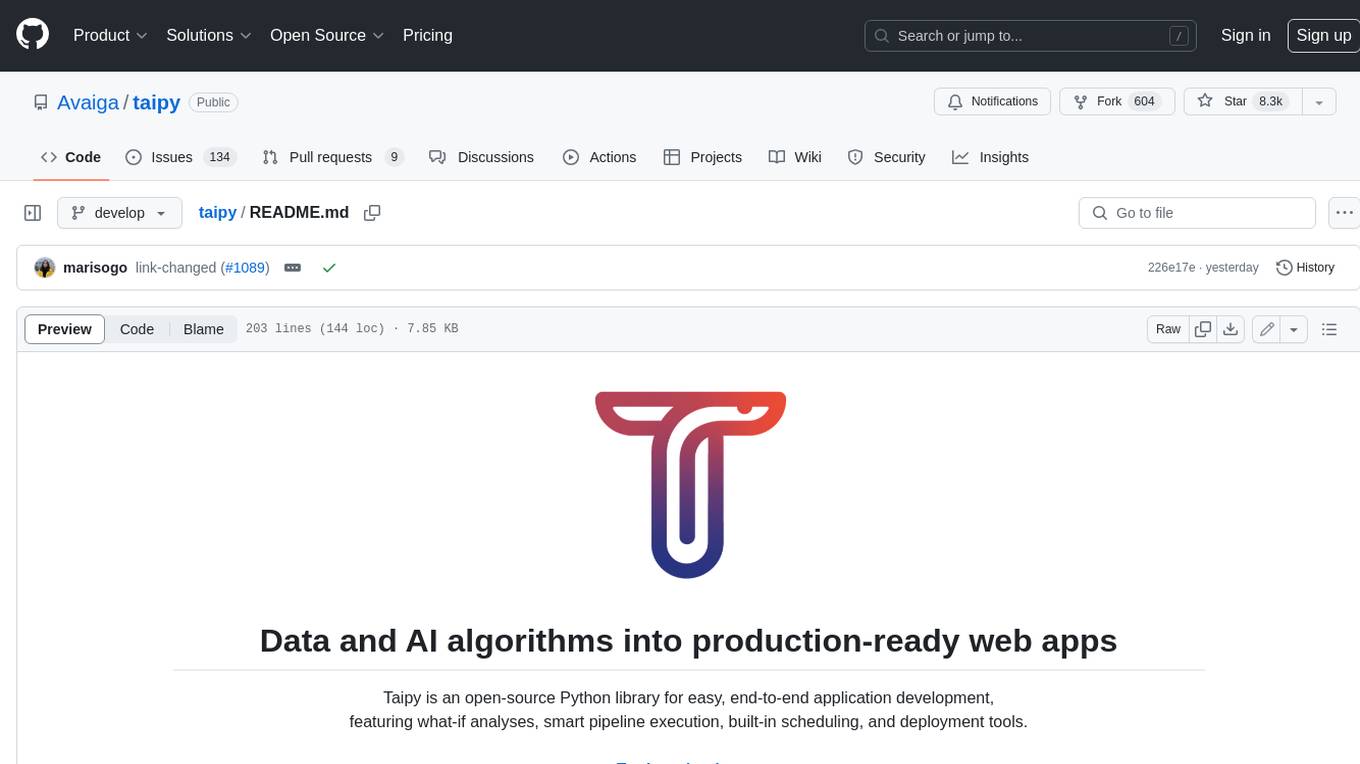
taipy
Taipy is an open-source Python library for easy, end-to-end application development, featuring what-if analyses, smart pipeline execution, built-in scheduling, and deployment tools.
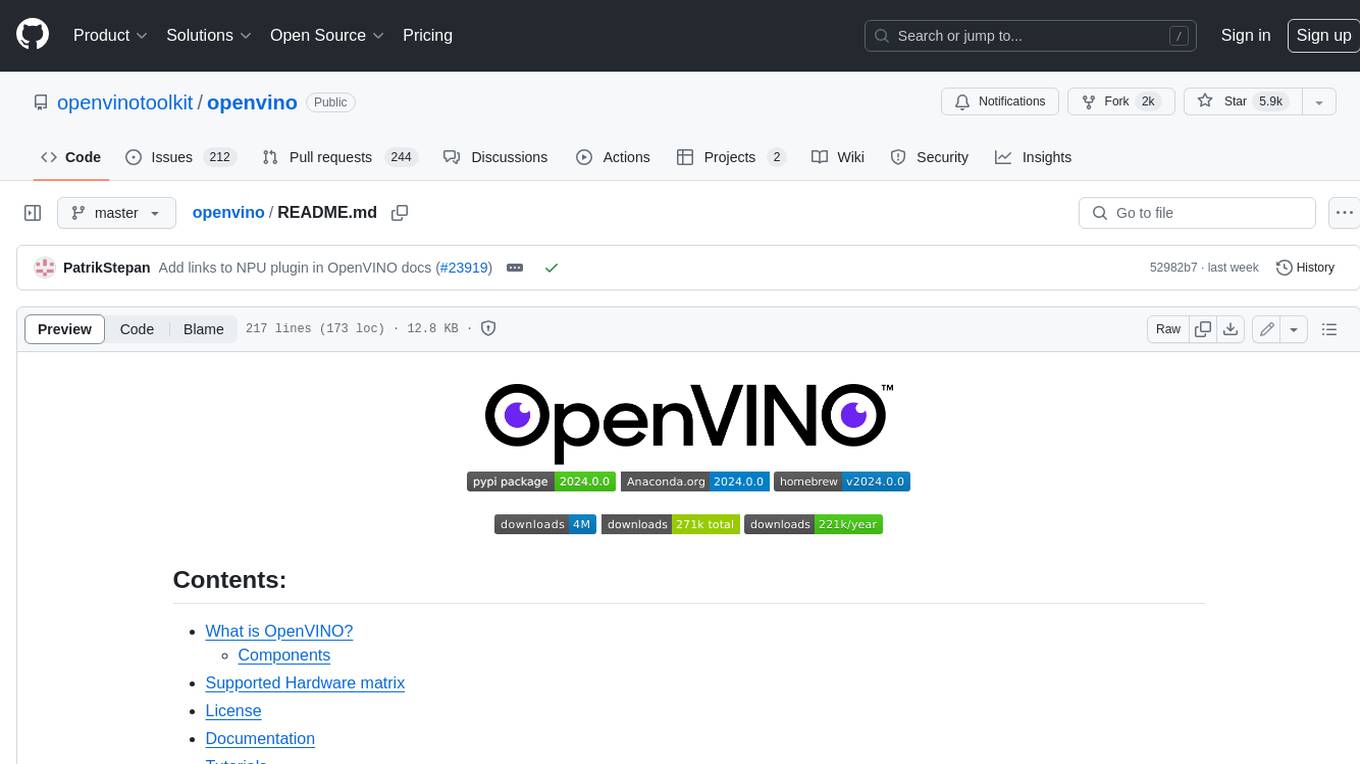
openvino
OpenVINO™ is an open-source toolkit for optimizing and deploying AI inference. It provides a common API to deliver inference solutions on various platforms, including CPU, GPU, NPU, and heterogeneous devices. OpenVINO™ supports pre-trained models from Open Model Zoo and popular frameworks like TensorFlow, PyTorch, and ONNX. Key components of OpenVINO™ include the OpenVINO™ Runtime, plugins for different hardware devices, frontends for reading models from native framework formats, and the OpenVINO Model Converter (OVC) for adjusting models for optimal execution on target devices.
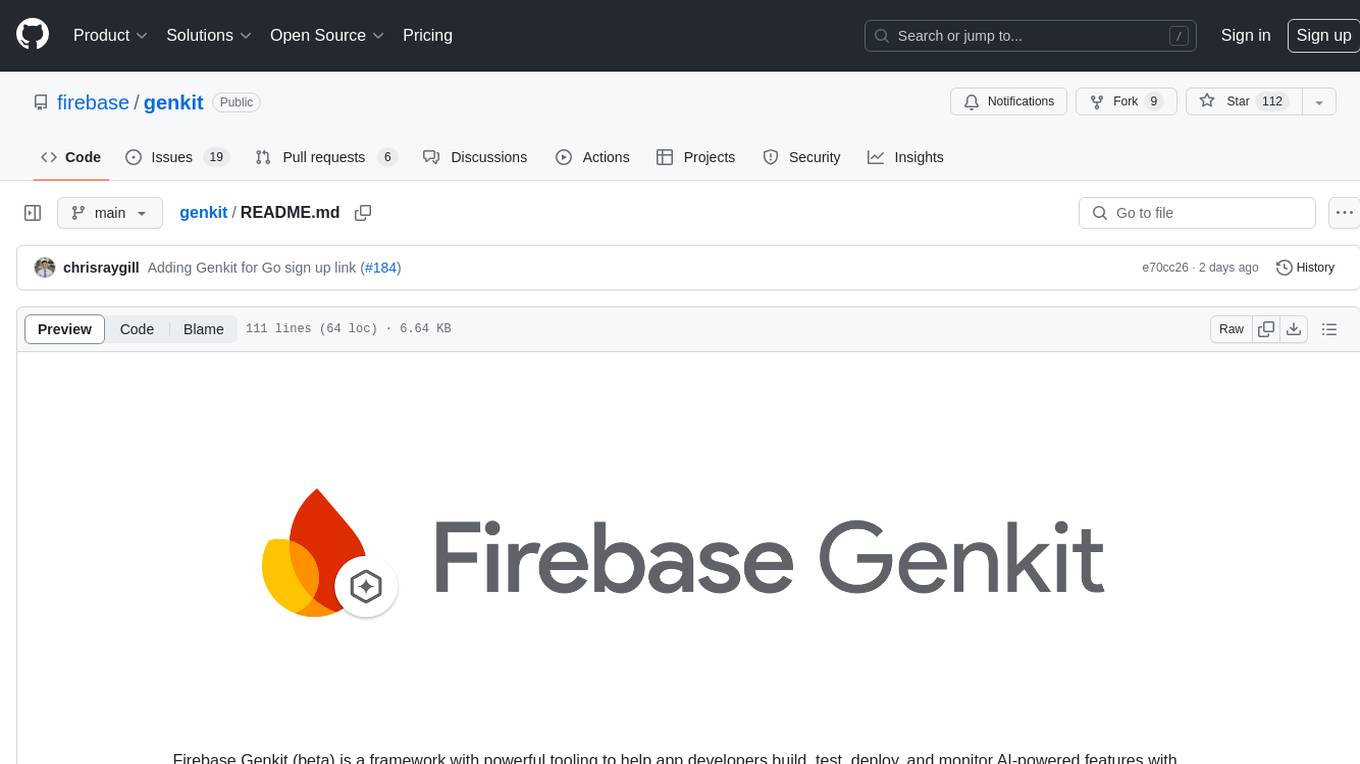
genkit
Firebase Genkit (beta) is a framework with powerful tooling to help app developers build, test, deploy, and monitor AI-powered features with confidence. Genkit is cloud optimized and code-centric, integrating with many services that have free tiers to get started. It provides unified API for generation, context-aware AI features, evaluation of AI workflow, extensibility with plugins, easy deployment to Firebase or Google Cloud, observability and monitoring with OpenTelemetry, and a developer UI for prototyping and testing AI features locally. Genkit works seamlessly with Firebase or Google Cloud projects through official plugins and templates.
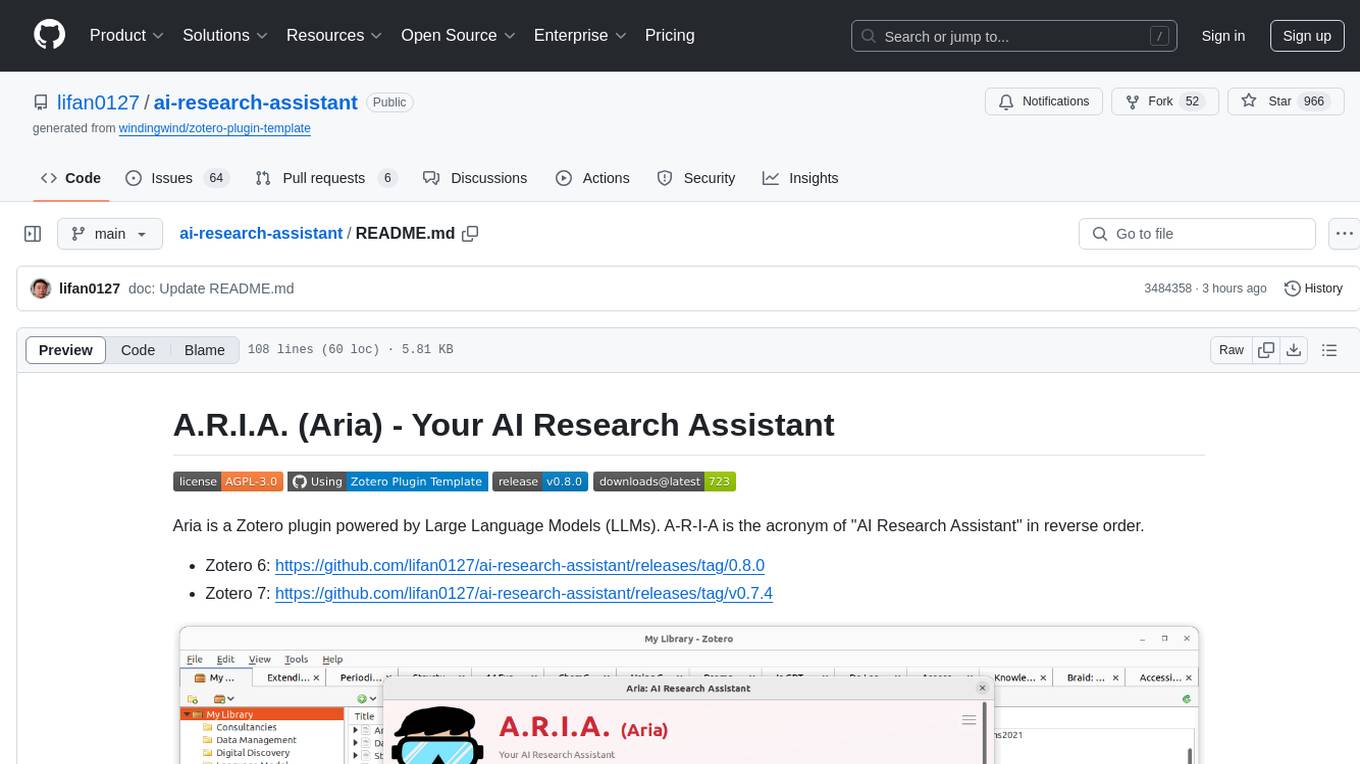
ai-research-assistant
Aria is a Zotero plugin that serves as an AI Research Assistant powered by Large Language Models (LLMs). It offers features like drag-and-drop referencing, autocompletion for creators and tags, visual analysis using GPT-4 Vision, and saving chats as notes and annotations. Aria requires the OpenAI GPT-4 model family and provides a configurable interface through preferences. Users can install Aria by downloading the latest release from GitHub and activating it in Zotero. The tool allows users to interact with Zotero library through conversational AI and probabilistic models, with the ability to troubleshoot errors and provide feedback for improvement.
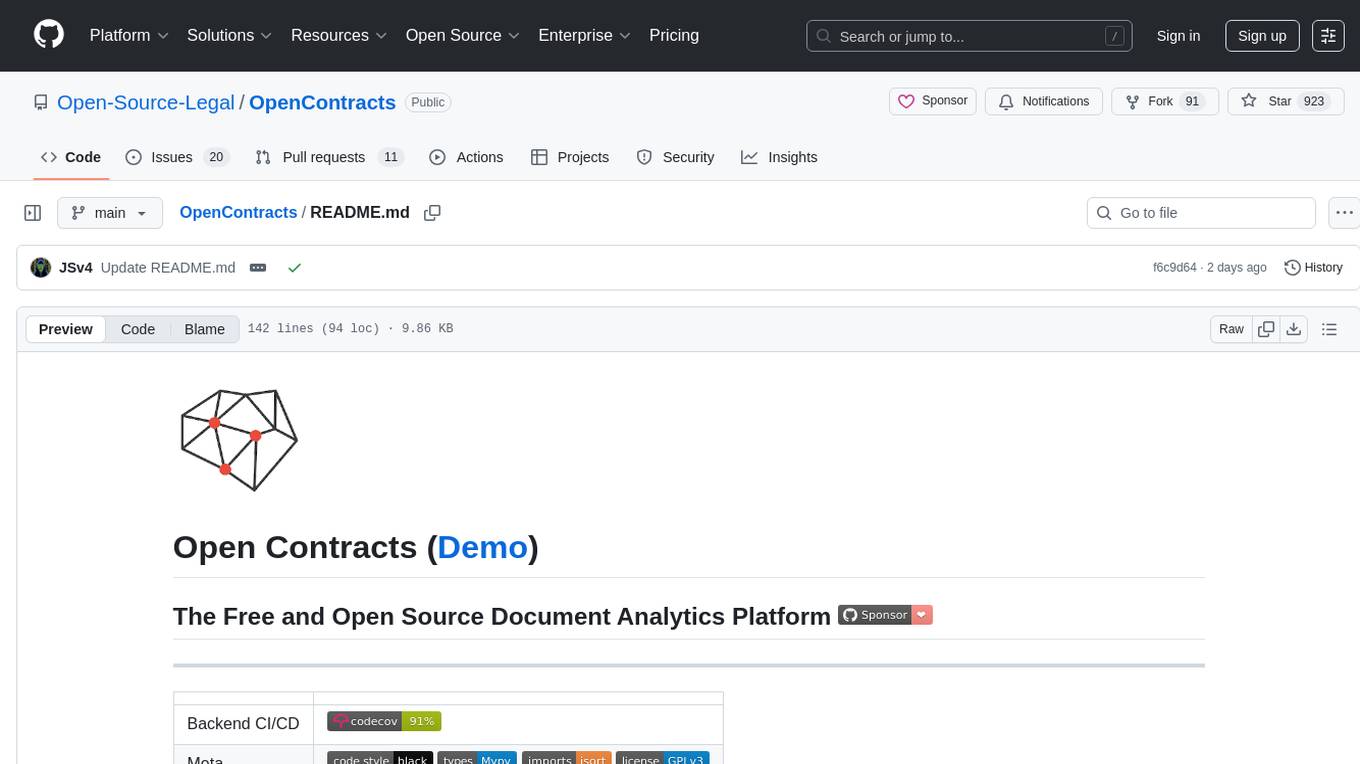
OpenContracts
OpenContracts is a free and open-source document analytics platform designed to empower knowledge owners and subject matter experts. It supports multiple document formats, ingestion pipelines, and custom document analytics tools. Users can manage documents, define metadata schemas, extract layout features, generate vector embeddings, deploy custom analyzers, support new document formats, annotate documents, extract bulk data, and create bespoke data extraction workflows. The tool aims to provide a standardized architecture for analyzing contracts and making data portable, with a focus on PDF and text-based formats. It includes features like document management, layout parsing, pluggable architectures, human annotation interface, and a custom LLM framework for conversation management and real-time streaming.
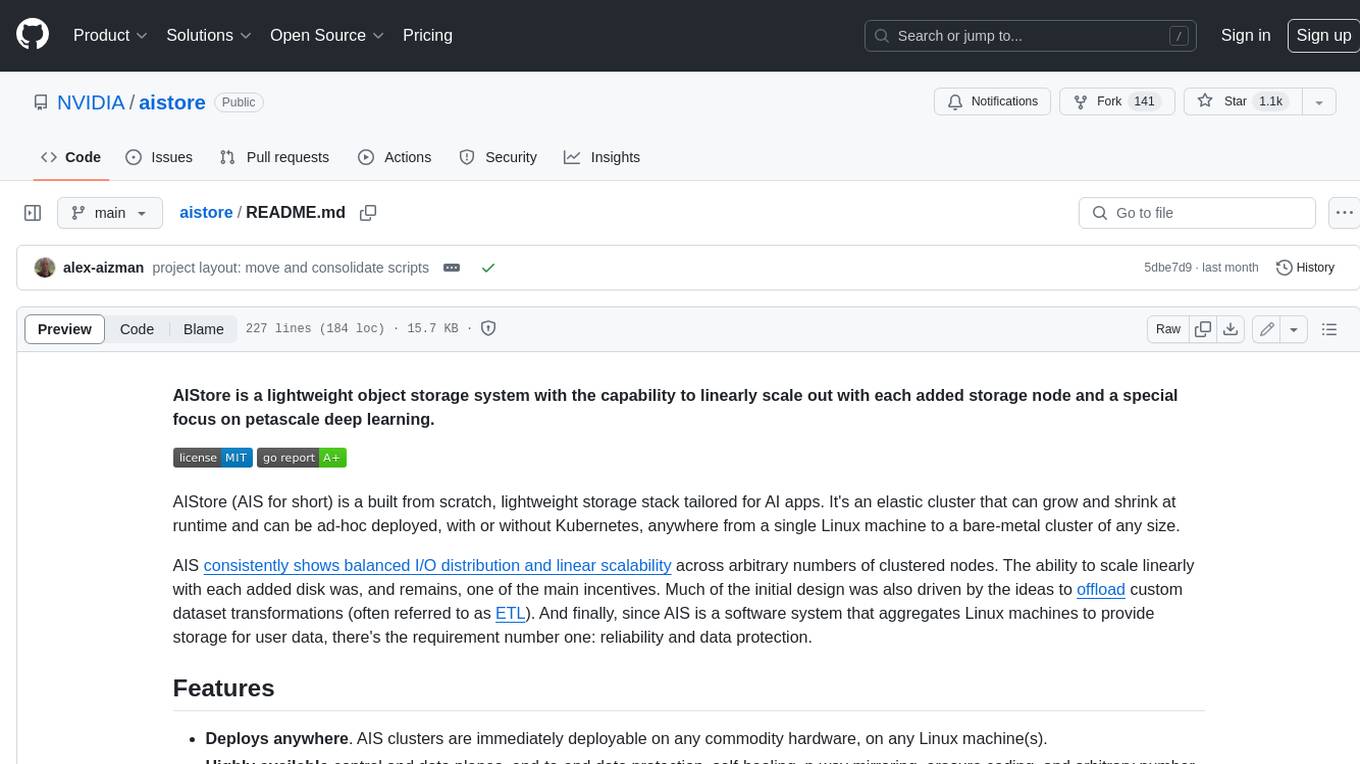
aistore
AIStore is a lightweight object storage system designed for AI applications. It is highly scalable, reliable, and easy to use. AIStore can be deployed on any commodity hardware, and it can be used to store and manage large datasets for deep learning and other AI applications.
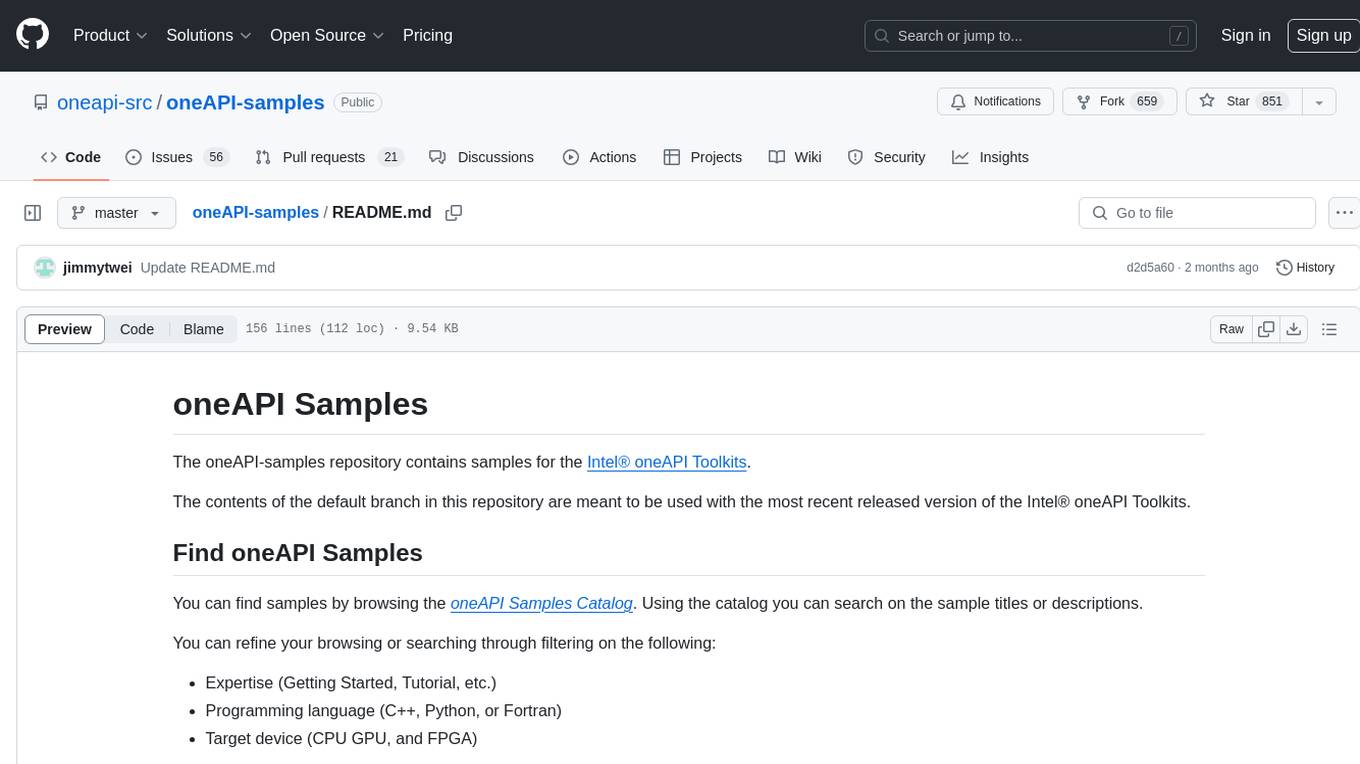
oneAPI-samples
The oneAPI-samples repository contains a collection of samples for the Intel oneAPI Toolkits. These samples cover various topics such as AI and analytics, end-to-end workloads, features and functionality, getting started samples, Jupyter notebooks, direct programming, C++, Fortran, libraries, publications, rendering toolkit, and tools. Users can find samples based on expertise, programming language, and target device. The repository structure is organized by high-level categories, and platform validation includes Ubuntu 22.04, Windows 11, and macOS. The repository provides instructions for getting samples, including cloning the repository or downloading specific tagged versions. Users can also use integrated development environments (IDEs) like Visual Studio Code. The code samples are licensed under the MIT license.
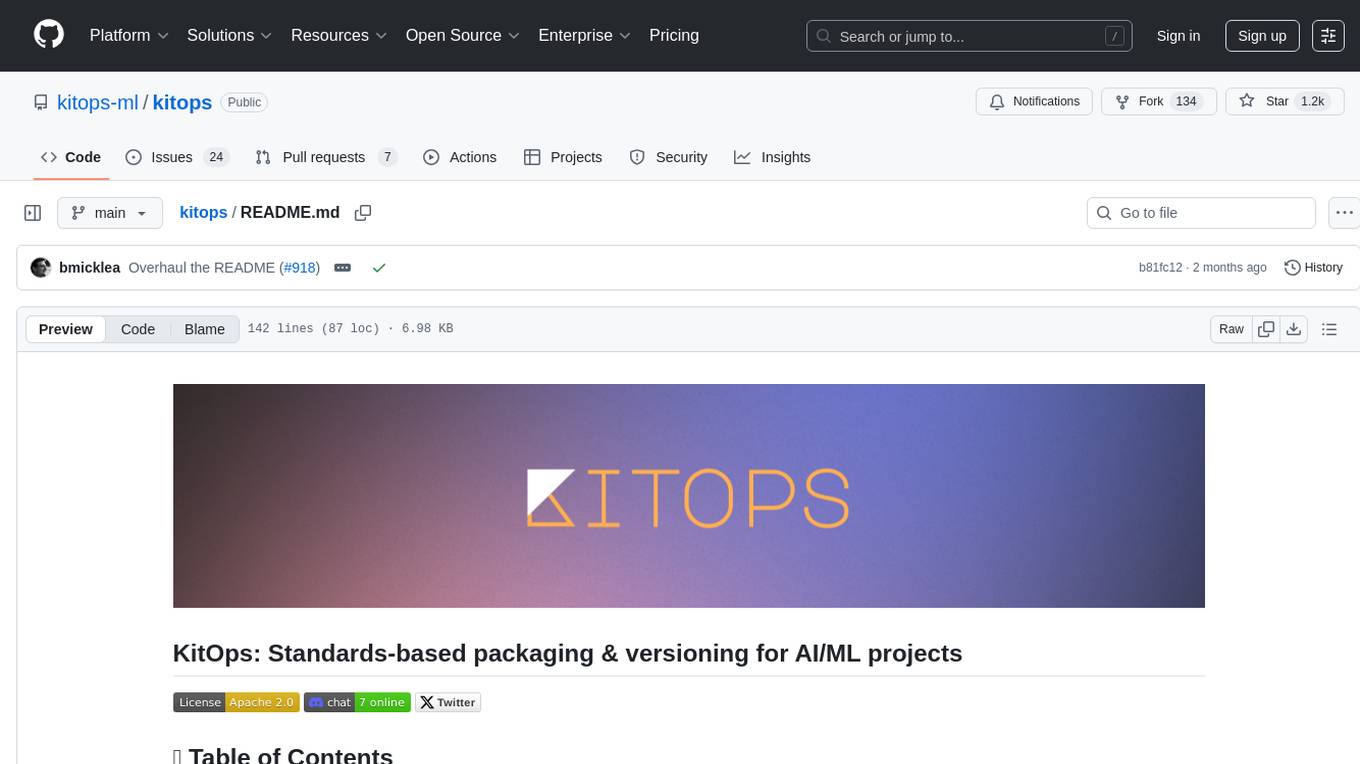
kitops
KitOps is a CNCF open standards project for packaging, versioning, and securely sharing AI/ML projects. It provides a unified solution for packaging, versioning, and managing assets in security-conscious enterprises, governments, and cloud operators. KitOps elevates AI artifacts to first-class, governed assets through ModelKits, which are tamper-proof, signable, and compatible with major container registries. The tool simplifies collaboration between data scientists, developers, and SREs, ensuring reliable and repeatable workflows for both development and operations. KitOps supports packaging for various types of models, including large language models, computer vision models, multi-modal models, predictive models, and audio models. It also facilitates compliance with the EU AI Act by offering tamper-proof, signable, and auditable ModelKits.

flow-like
Flow-Like is an enterprise-grade workflow operating system built upon Rust for uncompromising performance, efficiency, and code safety. It offers a modular frontend for apps, a rich set of events, a node catalog, a powerful no-code workflow IDE, and tools to manage teams, templates, and projects within organizations. With typed workflows, users can create complex, large-scale workflows with clear data origins, transformations, and contracts. Flow-Like is designed to automate any process through seamless integration of LLM, ML-based, and deterministic decision-making instances.
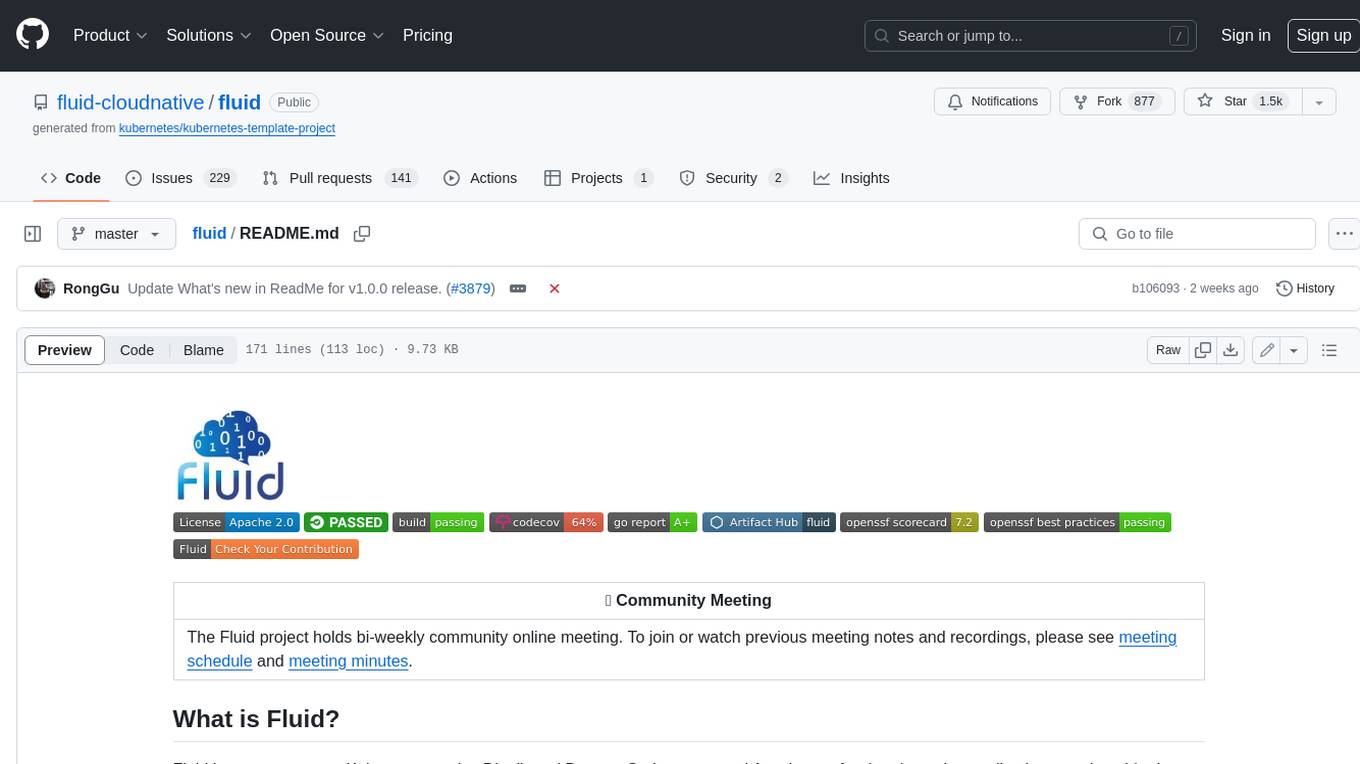
fluid
Fluid is an open source Kubernetes-native Distributed Dataset Orchestrator and Accelerator for data-intensive applications, such as big data and AI applications. It implements dataset abstraction, scalable cache runtime, automated data operations, elasticity and scheduling, and is runtime platform agnostic. Key concepts include Dataset and Runtime. Prerequisites include Kubernetes version > 1.16, Golang 1.18+, and Helm 3. The tool offers features like accelerating remote file accessing, machine learning, accelerating PVC, preloading dataset, and on-the-fly dataset cache scaling. Contributions are welcomed, and the project is under the Apache 2.0 license with a vendor-neutral approach.
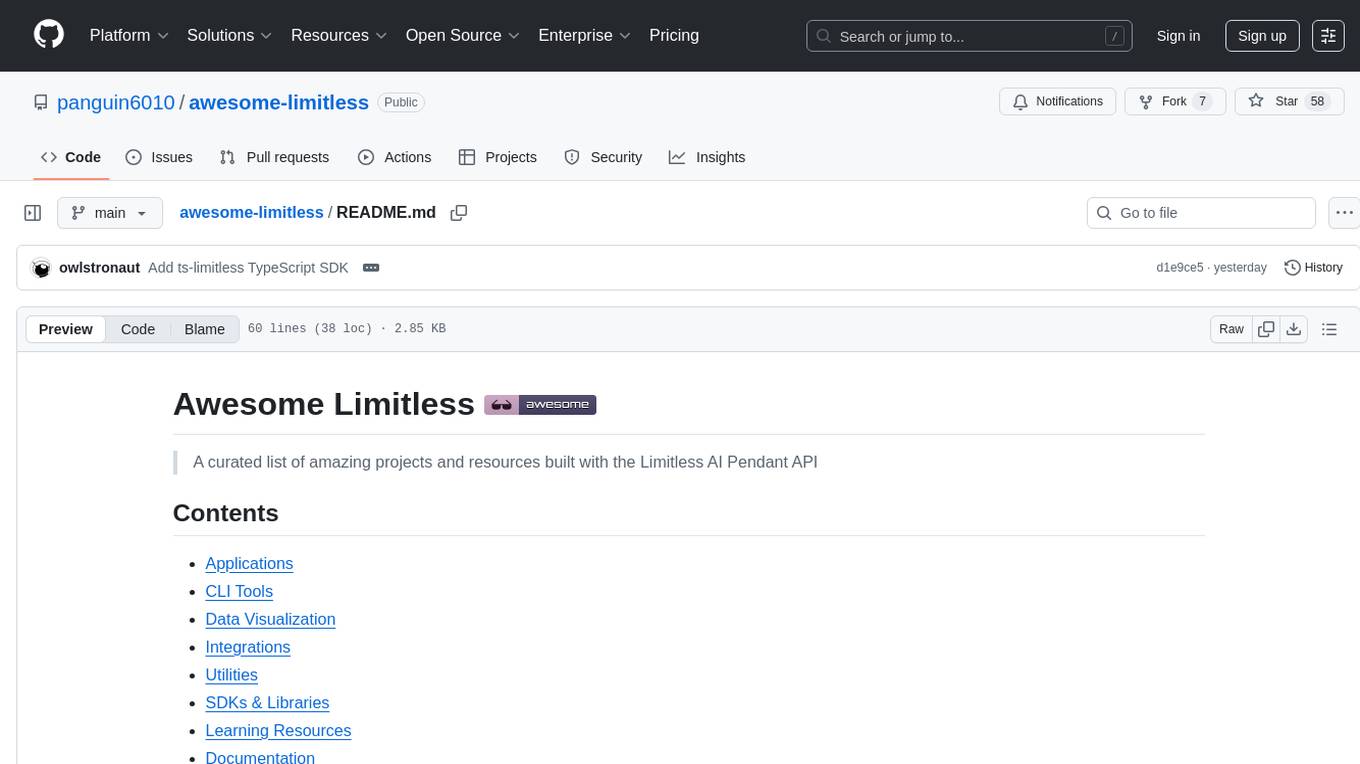
awesome-limitless
A curated list of amazing projects and resources built with the Limitless AI Pendant API. It includes applications, CLI tools, data visualization tools, integrations with plugins and extensions, utilities for server conversion and data ingestion, SDKs and libraries for Go and TypeScript, learning resources, and official API documentation.
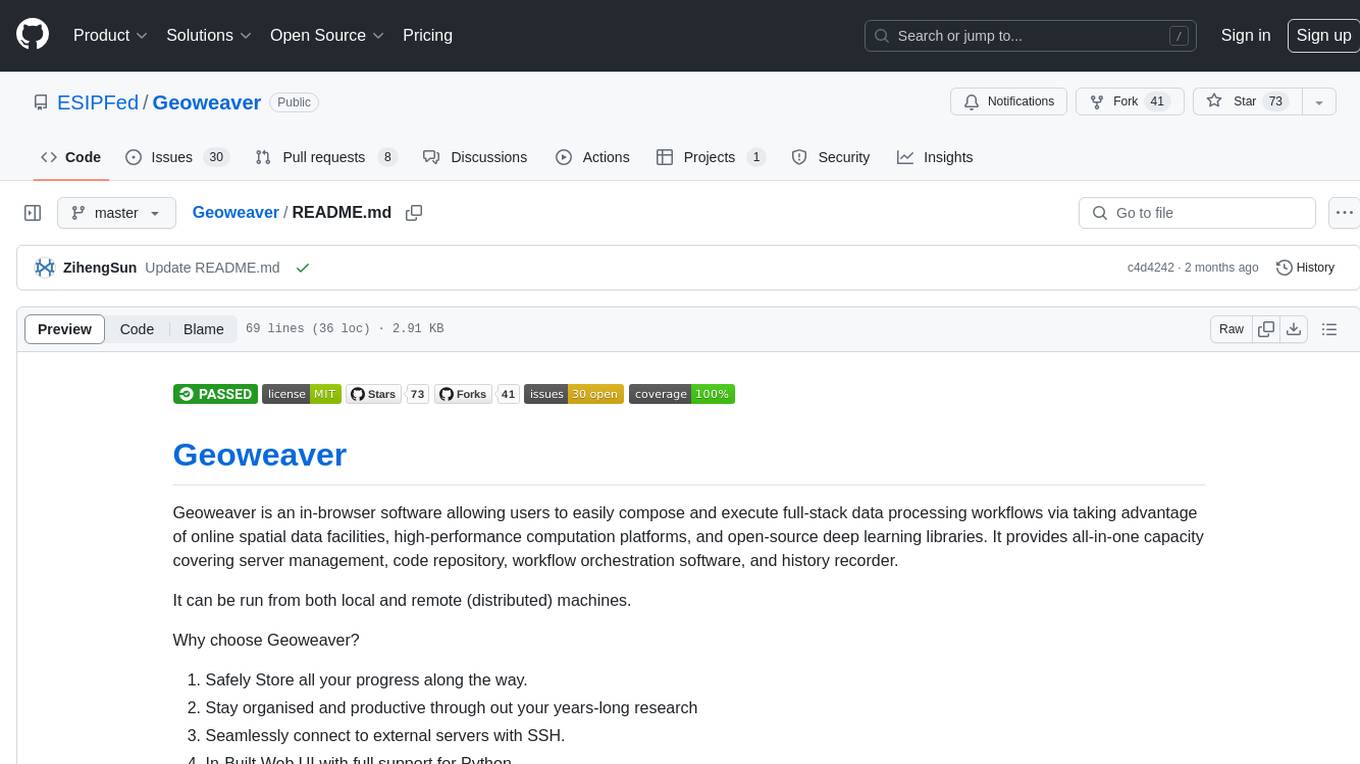
Geoweaver
Geoweaver is an in-browser software that enables users to easily compose and execute full-stack data processing workflows using online spatial data facilities, high-performance computation platforms, and open-source deep learning libraries. It provides server management, code repository, workflow orchestration software, and history recording capabilities. Users can run it from both local and remote machines. Geoweaver aims to make data processing workflows manageable for non-coder scientists and preserve model run history. It offers features like progress storage, organization, SSH connection to external servers, and a web UI with Python support.
For similar tasks

thecodersgig
TheCodersGig is an AI-powered open-source social network platform for developers, facilitating seamless connection and collaboration. It features an integrated utility marketplace for creating plugins easily, automating backend development with scalable code. The user-friendly interface supports API integration, data models, databases, authentication, and authorization. The platform's architecture includes frontend, backend, AI services, database, marketplace, security, and DevOps layers, enabling customization and diverse integrations. Key components encompass technologies like React.js, Node.js, Python-based AI frameworks, SQL/NoSQL databases, payment gateways, security protocols, and DevOps tools for automation and scalability.
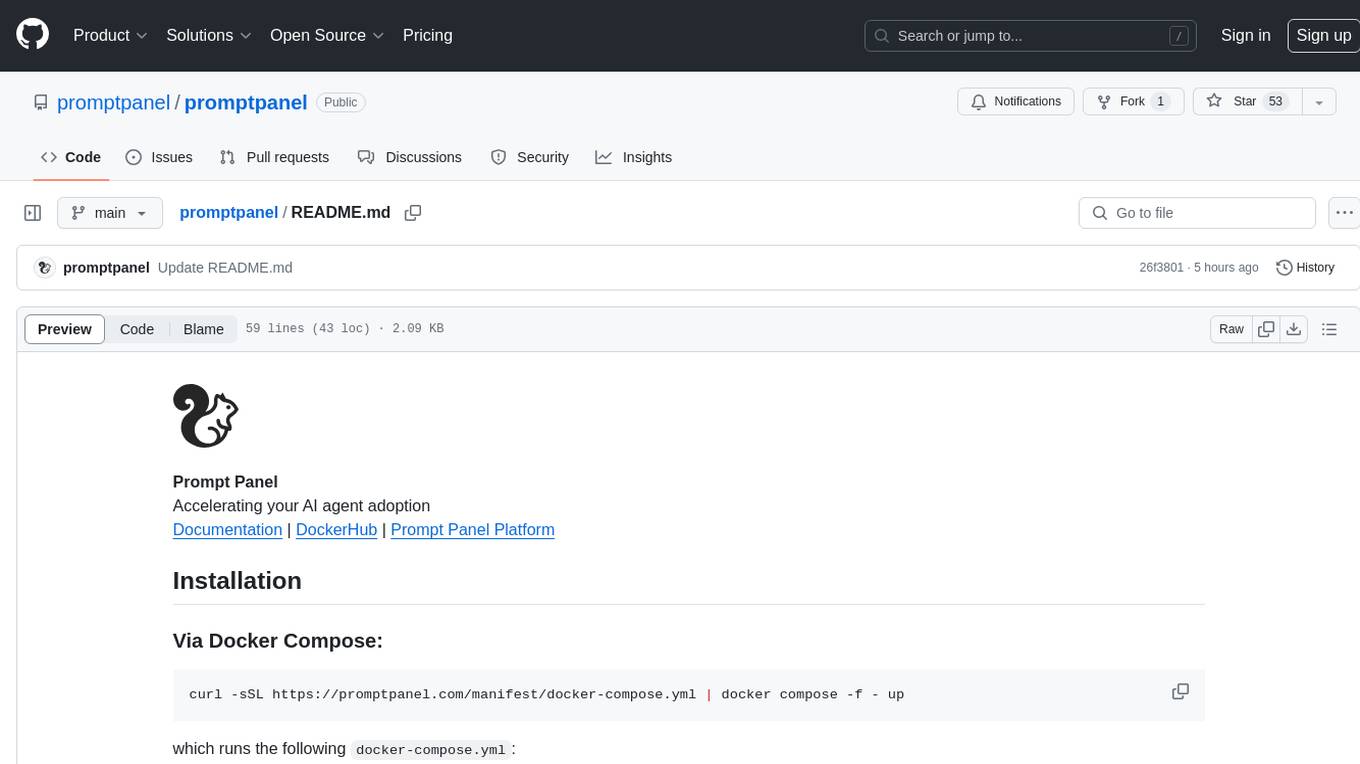
promptpanel
Prompt Panel is a tool designed to accelerate the adoption of AI agents by providing a platform where users can run large language models across any inference provider, create custom agent plugins, and use their own data safely. The tool allows users to break free from walled-gardens and have full control over their models, conversations, and logic. With Prompt Panel, users can pair their data with any language model, online or offline, and customize the system to meet their unique business needs without any restrictions.
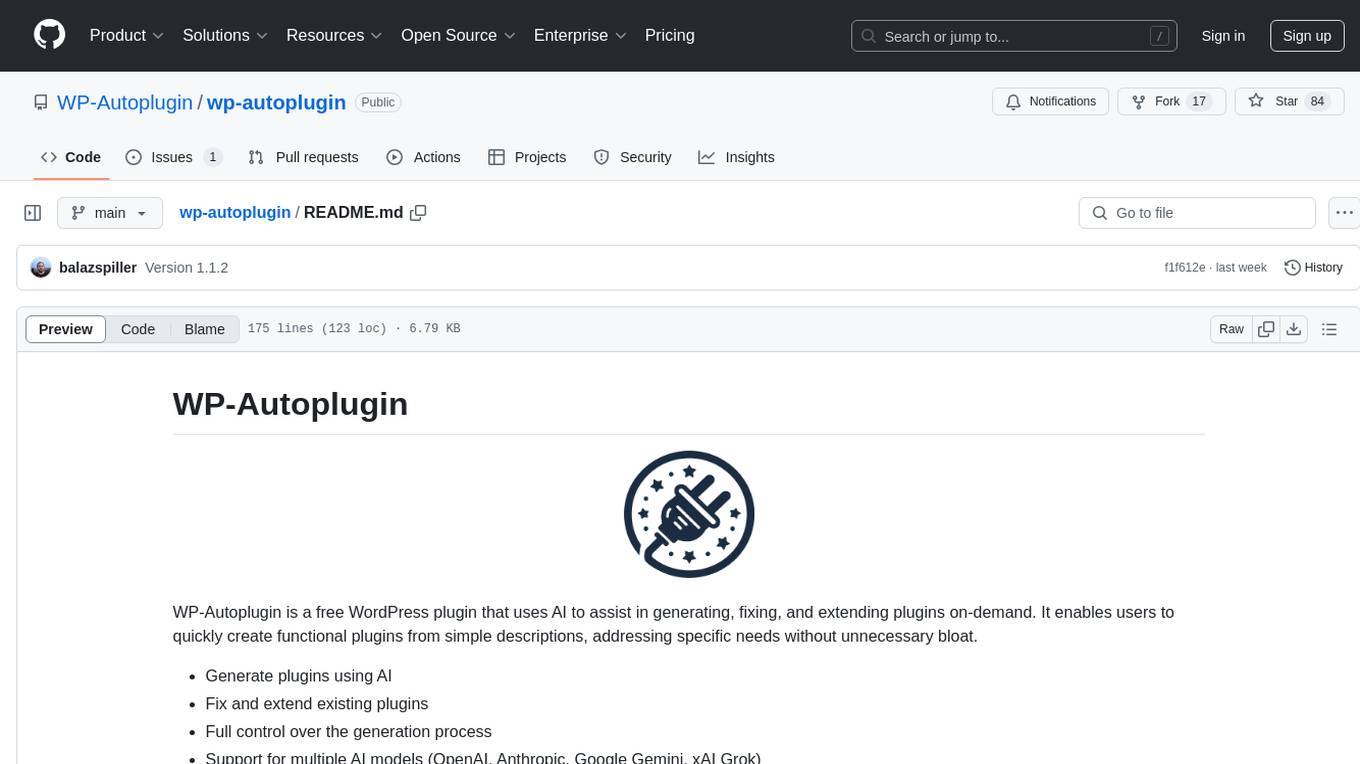
wp-autoplugin
WP-Autoplugin is a free WordPress plugin that uses AI to assist in generating, fixing, and extending plugins on-demand. It enables users to quickly create functional plugins from simple descriptions, addressing specific needs without unnecessary bloat. Users can generate plugins using AI, fix and extend existing plugins, have full control over the generation process, view the list of generated plugins for easy management, and auto-detect fatal errors. The plugin offers practical solutions for creating lightweight alternatives, custom solutions, and developer foundations. It supports various AI models like GPT-3.5 Turbo, GPT-4, Claude 3.5 Sonnet, Google Gemini Flash 2.0, xAI Grok-beta, and more. WP-Autoplugin is completely free, open-source, privacy-focused, and allows users to bring their own API key for AI usage.
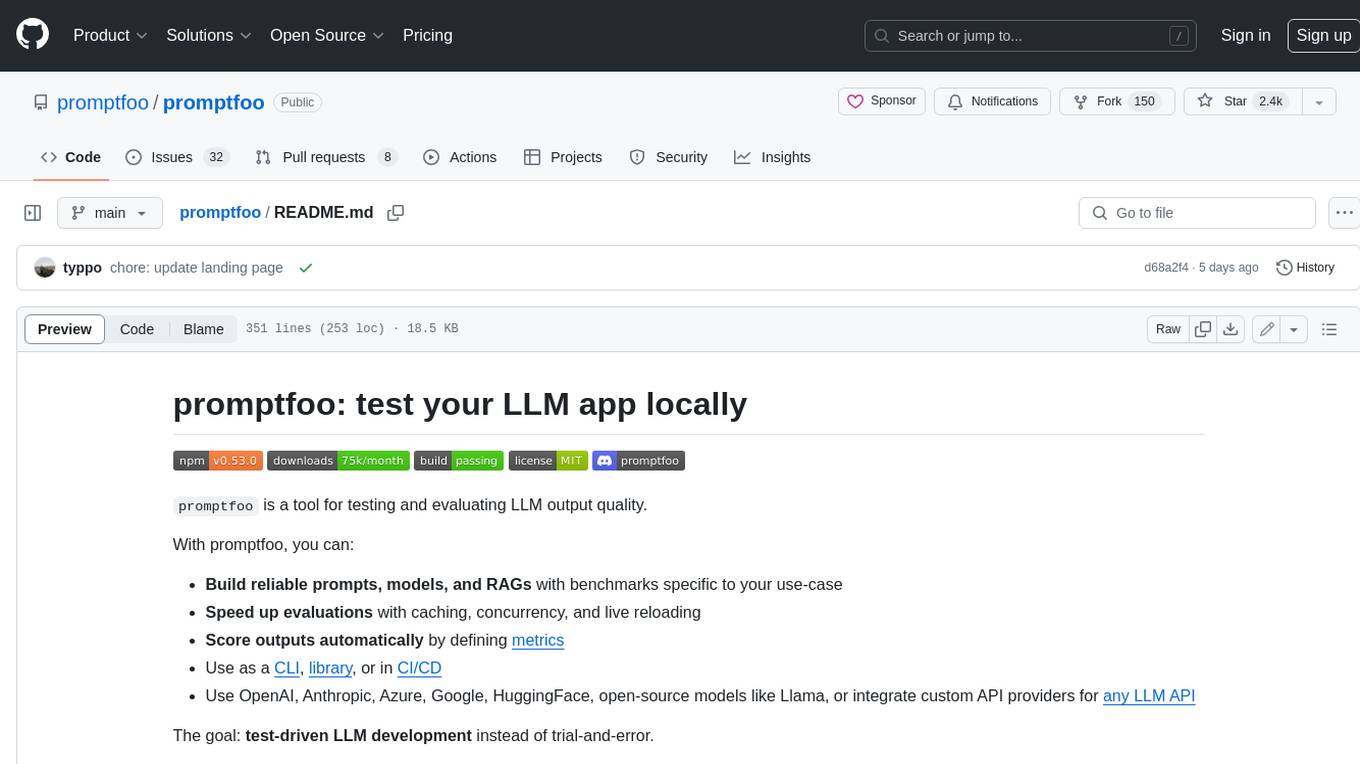
promptfoo
Promptfoo is a tool for testing and evaluating LLM output quality. With promptfoo, you can build reliable prompts, models, and RAGs with benchmarks specific to your use-case, speed up evaluations with caching, concurrency, and live reloading, score outputs automatically by defining metrics, use as a CLI, library, or in CI/CD, and use OpenAI, Anthropic, Azure, Google, HuggingFace, open-source models like Llama, or integrate custom API providers for any LLM API.
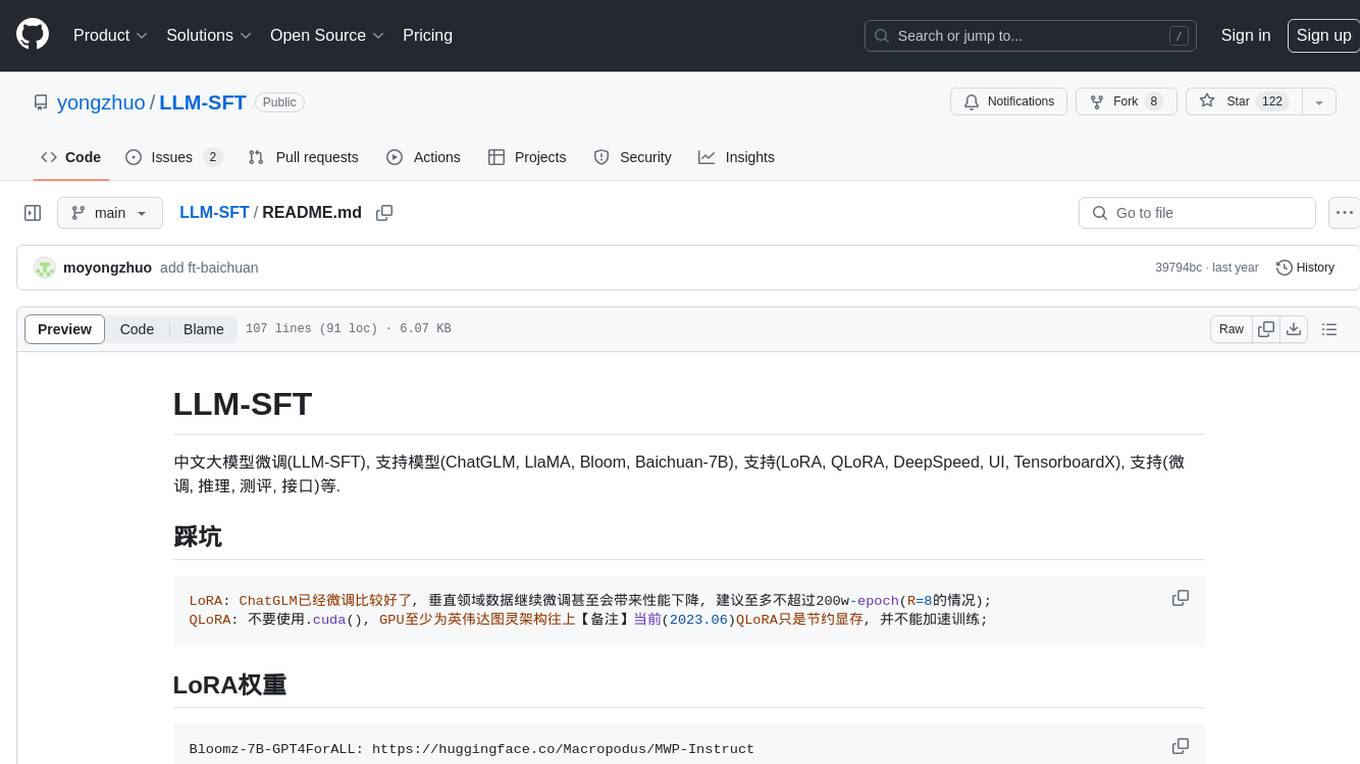
LLM-SFT
LLM-SFT is a Chinese large model fine-tuning tool that supports models such as ChatGLM, LlaMA, Bloom, Baichuan-7B, and frameworks like LoRA, QLoRA, DeepSpeed, UI, and TensorboardX. It facilitates tasks like fine-tuning, inference, evaluation, and API integration. The tool provides pre-trained weights for various models and datasets for Chinese language processing. It requires specific versions of libraries like transformers and torch for different functionalities.
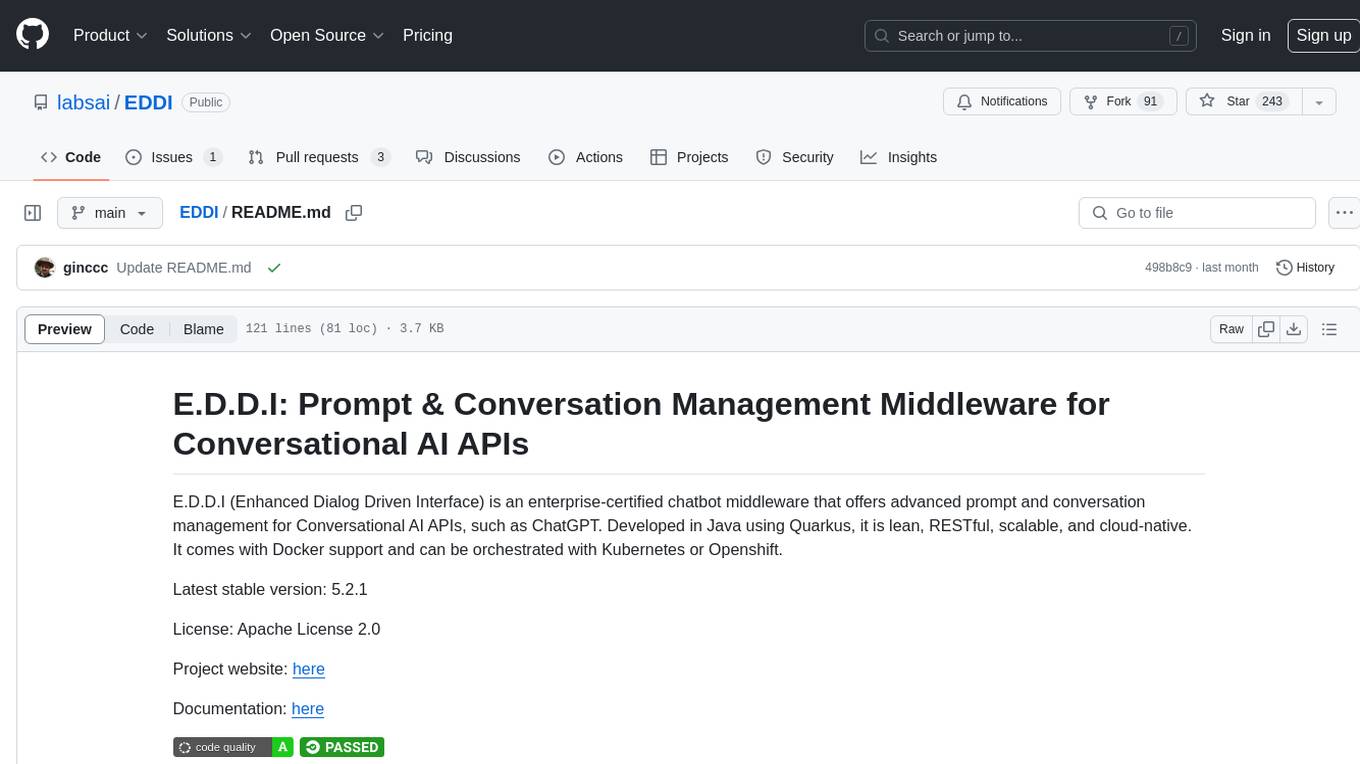
EDDI
E.D.D.I (Enhanced Dialog Driven Interface) is an enterprise-certified chatbot middleware that offers advanced prompt and conversation management for Conversational AI APIs. Developed in Java using Quarkus, it is lean, RESTful, scalable, and cloud-native. E.D.D.I is highly scalable and designed to efficiently manage conversations in AI-driven applications, with seamless API integration capabilities. Notable features include configurable NLP and Behavior rules, support for multiple chatbots running concurrently, and integration with MongoDB, OAuth 2.0, and HTML/CSS/JavaScript for UI. The project requires Java 21, Maven 3.8.4, and MongoDB >= 5.0 to run. It can be built as a Docker image and deployed using Docker or Kubernetes, with additional support for integration testing and monitoring through Prometheus and Kubernetes endpoints.
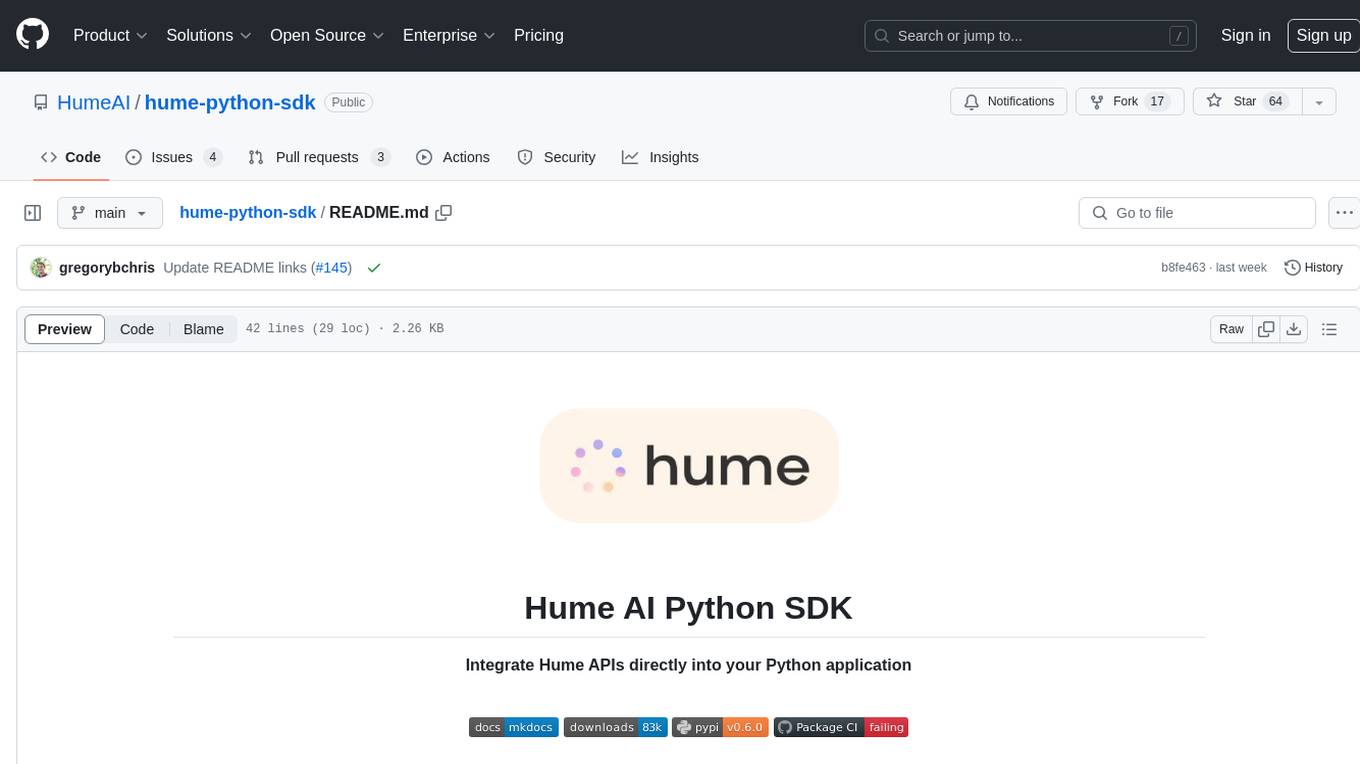
hume-python-sdk
The Hume AI Python SDK allows users to integrate Hume APIs directly into their Python applications. Users can access complete documentation, quickstart guides, and example notebooks to get started. The SDK is designed to provide support for Hume's expressive communication platform built on scientific research. Users are encouraged to create an account at beta.hume.ai and stay updated on changes through Discord. The SDK may undergo breaking changes to improve tooling and ensure reliable releases in the future.
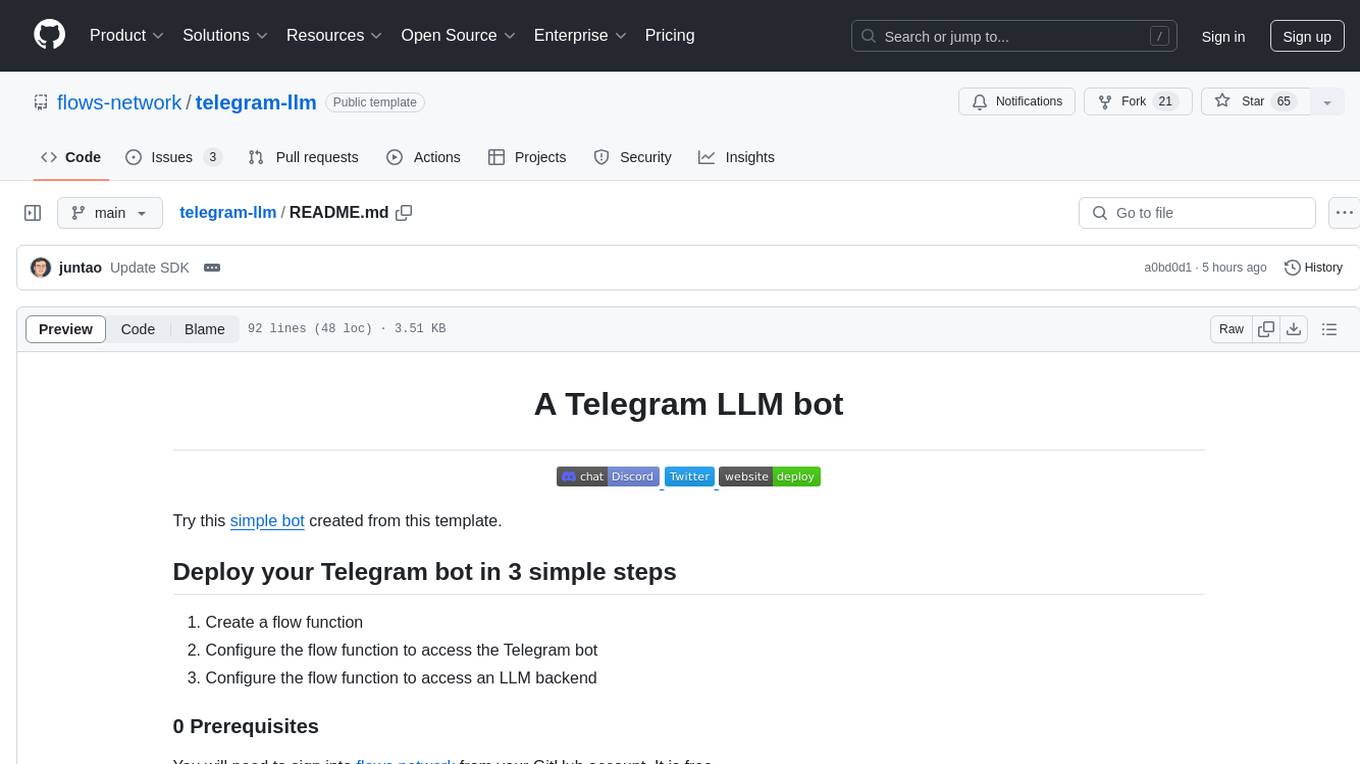
telegram-llm
A Telegram LLM bot that allows users to deploy their own Telegram bot in 3 simple steps by creating a flow function, configuring access to the Telegram bot, and connecting to an LLM backend. Users need to sign into flows.network, have a bot token from Telegram, and an OpenAI API key. The bot can be customized with ChatGPT prompts and integrated with OpenAI and Telegram for various functionalities.
For similar jobs

sweep
Sweep is an AI junior developer that turns bugs and feature requests into code changes. It automatically handles developer experience improvements like adding type hints and improving test coverage.

teams-ai
The Teams AI Library is a software development kit (SDK) that helps developers create bots that can interact with Teams and Microsoft 365 applications. It is built on top of the Bot Framework SDK and simplifies the process of developing bots that interact with Teams' artificial intelligence capabilities. The SDK is available for JavaScript/TypeScript, .NET, and Python.

ai-guide
This guide is dedicated to Large Language Models (LLMs) that you can run on your home computer. It assumes your PC is a lower-end, non-gaming setup.

classifai
Supercharge WordPress Content Workflows and Engagement with Artificial Intelligence. Tap into leading cloud-based services like OpenAI, Microsoft Azure AI, Google Gemini and IBM Watson to augment your WordPress-powered websites. Publish content faster while improving SEO performance and increasing audience engagement. ClassifAI integrates Artificial Intelligence and Machine Learning technologies to lighten your workload and eliminate tedious tasks, giving you more time to create original content that matters.

chatbot-ui
Chatbot UI is an open-source AI chat app that allows users to create and deploy their own AI chatbots. It is easy to use and can be customized to fit any need. Chatbot UI is perfect for businesses, developers, and anyone who wants to create a chatbot.

BricksLLM
BricksLLM is a cloud native AI gateway written in Go. Currently, it provides native support for OpenAI, Anthropic, Azure OpenAI and vLLM. BricksLLM aims to provide enterprise level infrastructure that can power any LLM production use cases. Here are some use cases for BricksLLM: * Set LLM usage limits for users on different pricing tiers * Track LLM usage on a per user and per organization basis * Block or redact requests containing PIIs * Improve LLM reliability with failovers, retries and caching * Distribute API keys with rate limits and cost limits for internal development/production use cases * Distribute API keys with rate limits and cost limits for students

uAgents
uAgents is a Python library developed by Fetch.ai that allows for the creation of autonomous AI agents. These agents can perform various tasks on a schedule or take action on various events. uAgents are easy to create and manage, and they are connected to a fast-growing network of other uAgents. They are also secure, with cryptographically secured messages and wallets.

griptape
Griptape is a modular Python framework for building AI-powered applications that securely connect to your enterprise data and APIs. It offers developers the ability to maintain control and flexibility at every step. Griptape's core components include Structures (Agents, Pipelines, and Workflows), Tasks, Tools, Memory (Conversation Memory, Task Memory, and Meta Memory), Drivers (Prompt and Embedding Drivers, Vector Store Drivers, Image Generation Drivers, Image Query Drivers, SQL Drivers, Web Scraper Drivers, and Conversation Memory Drivers), Engines (Query Engines, Extraction Engines, Summary Engines, Image Generation Engines, and Image Query Engines), and additional components (Rulesets, Loaders, Artifacts, Chunkers, and Tokenizers). Griptape enables developers to create AI-powered applications with ease and efficiency.